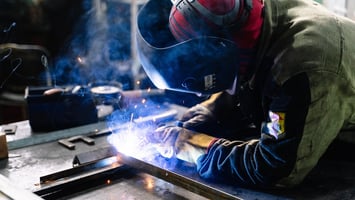Can partial tariff lifts on steel and aluminum help manufacturing in the United States? Some...
Kryton Metals Blog
Why Metal Manufacturing is Shifting to the U.S. and What it Means

The risks of doing business with China have made news in recent years, and the COVID-19 pandemic has exposed the need for less dependence on a foreign supply chain. Even though the benefits of doing business in the Far East can be significant, factors that include government regulations, quality control, and cultural differences are causing American companies to re-think their decision to outsource there.
While few would dispute that sourcing offshore was burdened by regulatory, quality, and communication issues, the lower labor, and operating costs offset many of the inherent risks. However, another problem frequently cited with offshore sourcing was constant glitches from supply chain disruptions and delivery issues. The COVID-19 pandemic heightened these difficulties even more.
Why is metal fabrication moving back to the U.S. from overseas?
Metal fabrication has been flying under the radar for some time. Described as both overlooked and underrated, the industry was recently valued at $20 billion with estimates of $24.5 billion by 2026. Amid ongoing discussions about jobs and industries being outsourced overseas, metal fabricators have been returning to the states as international costs have risen. As a matter of fact, a substantial portion of metal manufacturing was never even outsourced in the first place.
While lower labor costs tempted many businesses to outsource elsewhere, automation makes it possible for those in metal manufacturing to return to the United States with a competitive edge. The latest automation technology has enhanced manufacturing processes, allowing companies to provide higher-quality, lower-cost steel fabrication products delivered on schedule.
Automated fabrication technology could include CNC laser cutting technology, CNC spinning lathes, and other types of machinery. The industry is turning to robotics for welding, painting, assembly, and material handling. Enterprise resourcing planning software (ERP) improves efficiency, reporting, and production. In general, automation is resulting in safer and more productive work environments here in the United States.
What challenges remain for the metal manufacturing industry?
Despite the benefits that automation provides, labor shortages continue to plague American manufacturing. Skilled workers are in demand as manufacturers attempt to expand production and replace a slew of experienced operators and supervisors who have retired in the past few years.
Because the manufacturing sector is connected to so many other industries, it needs trained employees to provide the required services. Automation is a partial solution, enabling a certain amount of unmanned production. However, retaining a highly skilled team within the workplace is essential to their success.
Some of the other challenges the industry faces include:
- Managing the supply chain: Outsourcing specific processes speeds deliveries and saves money, but it can be challenging to keep track of them.
- Increased customer demands: Customers are under pressure to meet deliveries, and those burdens are passed on to the metal manufacturer to find a way to get their products ASAP.
- Higher costs: Many factors, including tariffs and trade wars, can contribute to higher prices and lower profits. Managing them without sacrificing quality will always be difficult.
Why are steel prices so high, and when will they stabilize?
Steel prices have risen a whopping 215% since March 2020, with the benchmark price for hot-rolled steel hitting an all-time of $1,825 in July of 2021. Before the COVID-19 pandemic, it traded between $500 and $800.
What happened? The initial months of the virus saw many steel mills stopping production, fearing a long-lasting recession. But the decline in consumer demand was short-lived as they quickly began buying steel-laden products such as appliances, vehicles, and lawn equipment. Steel intensive do-it-yourself projects also helped to fuel the price increase.
However, while the decline in DIY has helped ease the price of lumber, steel prices continue to go up unabated. The reason? Steel-heavy industries--oil and gas, for instance--are experiencing increases in steel demand as the economy resurrects. And, as workers commute to on-sight jobs and air travel begins in earnest, oil producers and refineries will need even more steel.
Will steel prices stabilize soon? Thorsten Schier, a metals expert at Fastmarkets, doesn't think so. "There doesn't appear to be any sign that it (the price of steel) is abating anytime soon. I don't think we've hit the peak for steel prices. Most people in the market see strength through the third quarter, and some don't see it getting better on the buying side until 2022 sometime."
KRYTON Metals is an ISO-certified manufacturer of spun metal components and fabricated parts across several industries.



